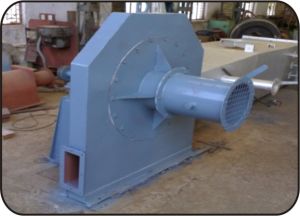
Mobile Conveyors
Kwik VAC mobile pneumatic conveying system are used in agriculture, food processing sector . It is capable of vacuuming the bulk solid from one point and transfering it to another point by pressure. A flexible suction hose is used to vacuum the material from basement silo container etc. Bulk material is conveyed to silo, truck, basement etc. by air pressure through the discharge hose. An optional discharge cyclone is connected to discharge hose which provides an easier truck loading. One user is enough for conveying operations. It can be operated by either electrical motor, diesel engine or tractor. Special hinge mechanism lets them to be carried by tractor. Features: Bulk material does not pass through any high speed device like fan or propeller. Therefore no harm is seen on conveyed product. Dust Free Operation. No Moving parts like augers. Product degradation is minimal. No adjustment required. Longer conveying distance. In Built Bag Filer System.
...more
Light Duty Blowers / FANS
Arrangement Belt Drive, Direct Drive, Cantilever, Overhung Accessories available as required Applications Oven and dryer systems Pneumatic Conveying Clean-Side dust collection HVAC ventilation Air recirculation Air Knives Chemical Process Combustion Air Building Ventilation Fume removal Spray Booth exhaust Cooling
...more
Husk Conveying Systems
This is positive type of pneumatic conveying system which can be handle maximum capacity of 1 to 10 TPH of boiler fuel and can throw material at a distance in excess of 800 ft. The system consist of either single stage or a two stage fan or a roots blower which conveys the material through pipe ranging from 4 inch to 12 inch. The material is fed into the RAV through the material feeding hopper which is pushed by the air thrown by the fan. Long radius bend are used either in 90° or 45° so that the bends do not & wear out. Special material for bends is used to enhance its life. The material is conveyed through the line uptill the discharge point. If required a diverter can be used with the line to divert the material to some other place at one time only one line will convey.
...more
Industrial Dampers
Dampers are used to throttle the air entering or leaving a fan and to control airflow in branches of a system or at points of delivery. Dampers control airflow by changing the amount of restriction in an airstream. Increasing the restriction creates a larger pressure drop across the damper and dissipates some flow energy, while decreasing the restriction reduces he pressure differential and allows more airflow Single Blade Dampers This is the cheapest and simple type of damper normally fitted at fan inlet for manual control. This damper is suitable for situations where accurate volume flow is not required. Multivane Dampers Control dampers are offered with either parallel or opposed blades. Each style has distinguishing characteristics in regards to control of the fan’s performance plus a change in air velocity profile. Parallel blade dampers have excellent control over the range of 75% to 100% wide open volume due to the amount of control arm swing required to modulate the blades. Parallel blades are used when greater control is required near the top end of the volume operating range or for systems requiring two position (fully open or fully closed) operation. Parallel blades should not be used upstream of critical components due to uneven airflow. Opposed blade dampers offer the best control over the entire operating range. Opposed blades are used for applications where it is necessary to maintain even distribution of air downstream from the damper. This style of blade is the best selection for ducted outlets. Type of Dampers Backdraft Dampers Inlet Box Dampers Nested Inlet Vane Dampers External Inlet Vane Dampers
...more
ash handling systems
Vacuum conveying system is a unique system in itself. It is specially designed to cater to the industry where small space is available for ash disposal. The working of the system is very simple. Ash is sucked in a pipe through a secondary nozzle/hoods by vacuum. Ash is then separated from air by a cyclonic effect created inside the cyclone .Ash then drops down through the RAV on the platform or ash is collected in the trolley underneath, the dusty air passing through the pulse jet bag filters into the atmosphere through the high efficiency fan. The pulse jet bag filter is an online system which with the help of compressed air cleans the plant ash filled bags. The advantage of using a pulse jet bag filter is its feature of online cleaning without stopping the whole pet. The fine material after being pulse cleaned is collected in a RAV fitted under the bag filter & disposed off into the trolley. The bends used are made of high grade steel with anti abrasive coating to protect against the abrasiveness of ash. System requires minimum workers to operate for ash.
...more
dust collection systems
The first fabric filters, designed many years ago comprised a simple fabric bag (or series of bags) into which the dust laden air was blown to remove the contaminants. Inevitably the filter bags or sleeves became clogged with dust fairly quickly ad various devices such as shakers were incorporated to increase the operational life of the filter elements before cleaning was needed. The pulsejet filter has been developed more recently and is now widely recognized as the most efficient type of fabric filter available. The dust laden air is introduced via an entry manifold at the top of the filter dust chamber or in the case of very high dust loadings into a separate inlet aisle. Heavy particles are drawn onto the outside of the filter socks to form a dust cake. Periodic pulsing of the filter socks ( row by row) dislodges the dust cake into the hopper and thus maintains fabric permeability at a level which allows continuous operation. The Pulse, a short burst of compressed air, and clean air induced by the sonic nozzle pulse, causes a pressure wave to travel down the filter sock, inflating the fabric and dislodging the dust. Simultaneously the airflow is momentarily reversed, further assisting dust removal. The design of filters includes a high level entry which provides a downward movement in the dust chamber, further assisting to deposit dust in the hopper and avoiding the common problem of loss of efficiency due to re entrainment.
...moreBe first to Rate
Rate ThisOpening Hours